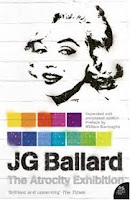Pablo
Picasso had his “blue period,” Max Ernst his “American years,” and Georgia
O’Keeffe her later “door-in-adobe” phase.
For J.G. Ballard, the early part of his career could be called his
“psychological catastrophe years.” Using
environmental disaster as a doorway to viewing minds under duress, novels like The Drowned World, The Drought, and The Crystal World unpacked the underlying subject matter. For the next phase of his career, Ballard
moved into the world of celebrity, media, violence, sexuality, and how they
distort and are distorted by reality.
Like any good artist, Ballard produced preliminary sketches prior to
delving into the longer length works of Crash,
Concrete Island, and High-Rise. Arguably as experimental as literature can
be, this initial feeling-out of mass media’s effect on the individual is 1970’s
The Atrocity Exhibition.
A
collage of Marilyn Monroe, fast cars, Vietnam War imagery, pornography, and
numerous other symbols of the 60s shredded into bits and pasted randomly back
together, The Atrocity Exhibition is
as much art as literature. Presentation literally mimicking a gallery
exhibition (i.e. the ability to walk in and let your gaze fall where it will),
readers looking for traditional storytelling should run. Like a later novel The Unlimited Dream Company, Ballard presents the same variety of
images, symbols, and conceptions from different angles, forcing the reader to
take a step back to view the larger whole.
There are thus recurring characters, but it is not their story, rather
the multi-perspective view to their experiences which address Ballard’s
concerns.
Normally
the writer places each word on the page with the intention it will be
read. The Atrocity Exhibition abandons this philosophy. In the introduction, Ballard encourages the
reader to dabble, to dip in and out, to get the flavor of the whole by sampling
randomly. The wall of scenes in the
gallery is to be observed. Most of the
artistic elements are common yet differ in array individually, and from that
the reader can draw their own conclusions .
If you are not a lover of visual art, then this aspect of the book can
be difficult to appreciate. As it’s the
main mode of presentation, I would even go so far to say that if the idea
doesn’t interest, don’t read the book.
Tolerances of the Human Face in Crash Impacts. Travers took the glass of whisky from Karen
Novotny. 'Who is Koester?—the crash on the motorway was a decoy. Half the time
we're moving about in other people's games.' He followed her on to the balcony.
The evening traffic turned along the outer circle of the park. The past few
days had formed a pleasant no-man's land, a dead zone on the clock. As she took
his arm in a domestic gesture he looked at her for the first time in half an
hour. This strange young woman, moving in a complex of undefined roles, the gun
moll of intellectual hoodlums with her art critical jargon and bizarre magazine
subscriptions. He had met her in the demonstration cinema during the interval,
immediately aware that she would form the perfect subject for the re-enactment
he had conceived. What were she and her fey crowd doing at a conference on
facial surgery? No doubt the lectures were listed in the diary pages of Vogue, with the
professors of tropical diseases as popular with their claques as fashionable
hairdressers. 'What about you, Karen?—wouldn't you like to be in the movies?'
With a stiff forefinger she explored the knuckle of his wrist. 'We're all in
the movies.'
A
novel only in the loosest sense possible, The
Atrocity Exhibition plays with structure, semiography, and semantics to
create ideas in the reader’s mind, that is, rather than convey ideas via
story. The true definition of a ‘mosaic
novel,’ Ballard examines the intersection of commercial art and reality, media
and the lives it presents, people who consume media, their perception of
reality, and the twisted reality of those in media. Fully focused on the effects of Vietnam-era
media on society, an absurdly extreme view is presented in the hope of exposing
some of the deeper paradigms at play in humanity—much like his earlier
‘psychological catastrophe’ novels, but with a deeper view to the interaction
of society and media. “World War III is now little more than a
sinister pop art display”one of the characters boldly states at one point.
The
version I read containing Ballard’s own chapter annotations, one finds such
quotes as: “a kind of banalization of
celebrity has occurred: we are now offered an instant, ready-to-mix fame as
nutritious as packet soup.” And that was in 1970. With the popularity of “reality tv” in
contemporary society, among several other things, one has to view The Atrocity Exhibition as a significant artistic statement regarding the surrounding human phenomena. The array of vignettes fascinating for their
imagery alone, pondering their significance in context with the whole makes for
fascinating, disturbing, and informative reading—one of the highest compliments
one can pay a piece of writing.


No comments:
Post a Comment